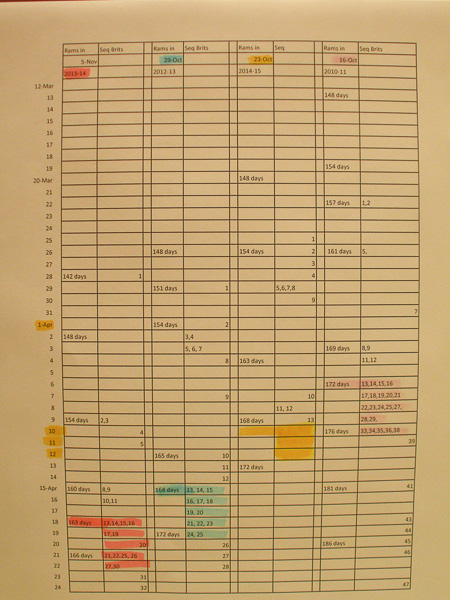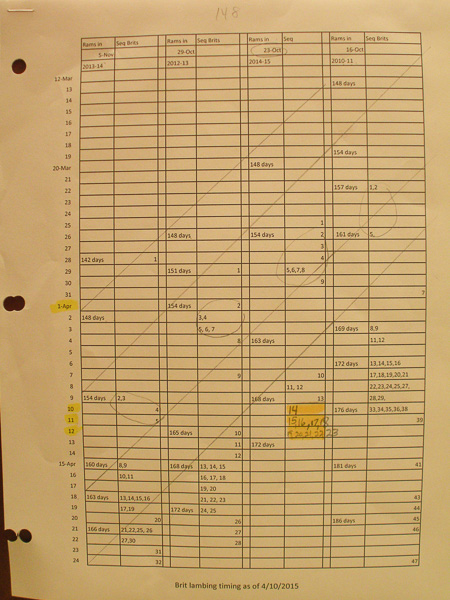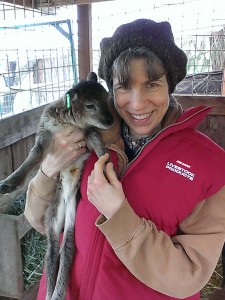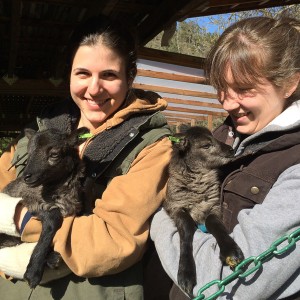Can a Soay shepherd “schedule” when lambs will arrive? A case study
This post serves two purposes: to provide an example of trying to time the start of breeding in order to enhance the odds of having at least a couple, and hopefully several, lambings in a very narrow window of time the next spring, and as a fitting ending to the saga of Lamb Camp 2015 on our farm.
Way back in August 2014 we knew we wanted, if at all possible, to have lambs born on April 10, 11, or 12, 2015, while our friend Ida, her daughter Whitney, and her niece Audrey, would be here to participate in lambing — Lamb Camp 2015. Short of identifying and then worshipping some sort of as-yet-unknown gestation goddess, and with a shortage of certified crystal ball readers in our neighborhood, we fell back on the old tried and true resource in our lives: data. As of last fall, we had birth records for over 440 British Soay lambs born on our farm over a span of nine years. If anything could help us, we felt certain it would be our own data.
Besides knowing exactly when we wanted some of our ewes to lamb, we also relied on the following:
(1) Prevailing wisdom places sheep gestation, or at least Soay sheep gestation, at about 148 days;
(2) We know from our experience that a few ewes will lamb about a week to ten days after the nominal “start date” for lambing, or between 154 and 161 days after we put the rams with the ewes; and
(3) The later we start breeding, the sooner the ewes and rams get down to business, because more of the ewes will already have started cycling in the fall. Are you with me so far?
(4) Each of the last several years, years when we had more than a handful of British ewes to breed, a sizable number of lambings took place between about 166 days and 176 days after we put the rams in, with this “cluster” trending towards the early side of that span when we bred late, and towards the later end of the span when we bred earlier. Here’s where the fun starts.
With a target of April 10, 11, and 12 — timed to coincide with Audrey’s spring break from teaching — we decided that we should start breeding on October 23, which would fall comfortably within the 166-176 day span, although obviously too broad if we wanted more certainty. We then checked our work by creating a rough table, shown here, that placed the tentative October 23 breeding start date about halfway between our 2010-11 start date of October 16 and our 2012-13 start date of October 29. You will notice the four years of data are not presented by lambing year, but rather by “rams in” date, the start of breeding. October 16 is about the earliest we have started breeding, and November 5 was one of the latest rams-in years for us. When we placed the four years of data in order according to when we started breeding, the pattern of concentrated lambings — the cluster — jumps right off the page (red – blue – yellow – purple). We were aiming for lots of lambs in the 3-day “yellow” section, April 10-12, 2015.
The big clump of lambings in 2011 (purple) did not start until 172 days, whereas the year we started breeding just two weeks later (2013, shown in blue), the wave of lambs started at 168 days. So we hoped that by putting the rams with the ewes halfway between those two comparison years — about halfway between October 16 and October 29 — we would have multiple lambings halfway between 166 and 176 days — specifically, days 169, 170, and 171 — the three days Ida and her girls would be here (shown in yellow).
Sometimes it is better to be lucky than good. In this case, it apparently was best to be both lucky and a little bit good. Here is the prediction chart as it stood after Lamb Camp. Note that before Lamb Camp started, I had typed in the sequence of early lambings as they were occurring, with an unnerving number in that first round. As Ida put it when I reported that 8 ewes had already lambed by March 29, “you tell those girls to hold their horses until we get there.”
I could not believe it when I started filling in the lambings by hand during Lamb Camp, with no time for fancy typed entries. When Darby lambed on April 10, we were enormously relieved; Whitney and Ida got to see a lambing. The next day, after Audrey arrived and as the lambs popped out one after another, we were high-fiving and dancing up and down the aisle between jugs full of bleating newborns and their moms. By the time we finally came in for a late dinner on Sunday the 12th, we were exhausted from welcoming four sets of twins and a single in one day.
You know those snarky disclaimers in the car ads during Super Bowl and the World Series, something like, “Professional driver on a closed course, do not attempt”? The same is true for trying to second-guess Soay ewes. Most of the time, they will not be trifled with. If we gloat too brazenly, our ewes surely will reward us with a haphazard pattern of lambing next year. Earnestly-delivered caution: do not tempt fate in this fashion!
But, if Ida and her kin want to come back again for Lamb Camp 2016, you can bet we are going to head right back to the data and see if we can get a repeat performance from our flock. Wouldn’t you?
For now …



